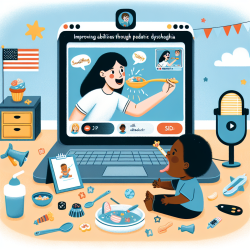Introduction to Telepractice in Pediatric Dysphagia
As practitioners in the field of speech-language pathology, we are continually seeking innovative methods to enhance the care we provide. One such advancement is the use of telepractice, particularly in the treatment of pediatric dysphagia. The research article "Telepractice for Pediatric Dysphagia: A Case Study" offers valuable insights into how telepractice can be effectively implemented to improve outcomes for children with feeding and swallowing disorders.
Understanding Pediatric Dysphagia
Pediatric dysphagia, or feeding and swallowing disorders, can significantly impact a child's health and quality of life. It involves difficulties in the oral, pharyngeal, or esophageal phases of swallowing, which can lead to complications such as malnutrition, aspiration pneumonia, and social isolation. These disorders are prevalent among children with developmental delays and Autism Spectrum Disorders, with prevalence rates ranging from 33% to 89%.
The Case Study: A Closer Look
The case study presented in the research involved a six-year-old boy with complex medical conditions, including Opitz BBB/G Syndrome and Asperger’s Syndrome. The child had significant feeding challenges, including dependency on gastrostomy tube feeding and severe aerophagia. The study aimed to assess the feasibility and effectiveness of a four-week intensive telepractice program.
Key Findings and Outcomes
- Behavioral Improvements: The child demonstrated a 69% decrease in latency for spoon acceptance and a 62% decrease for lollipop acceptance, indicating improved oral acceptance of eating-related objects.
- Swallowing Enhancements: There was an 89% reduction in latency for voluntary saliva swallows and a significant decrease in aerophagia levels.
- Quality of Life: The EAT-10 scores improved, reflecting better quality of life related to eating and swallowing.
Implications for Practice
This case study underscores the potential of telepractice as a viable method for delivering intensive dysphagia treatment to pediatric patients. The involvement of parents as mediators in the therapy sessions was crucial, highlighting the importance of family-centered approaches. The study also emphasized the need for systematic and structured therapy routines, which can be effectively delivered through telepractice.
Encouraging Further Research
While the results of this case study are promising, further research is needed to validate the findings across larger populations and diverse settings. Practitioners are encouraged to explore telepractice as a tool for expanding access to specialized care, particularly in underserved areas. By doing so, we can continue to improve the quality of life for children with dysphagia and their families.
To read the original research paper, please follow this link: Telepractice for Pediatric Dysphagia: A Case Study.










